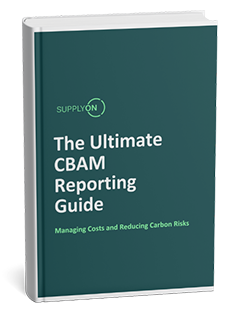Integrating Carbon Border Adjustment Mechanism (CBAM) in Procurement Strategies

As the Carbon Border Adjustment Mechanism (CBAM) reshapes the regulatory landscape, many businesses are still finding their ways to submit their quarterly report. However, CBAM must be strategically integrated in their procurement practices to ensure compliance and foster resilience. This article explores how CBAM can be part of such procurement strategies and have long term influence in how companies source, contract, manage supplier relationship and optimize.
Amidst the Carbon Border Adjustment Mechanism (CBAM), procurement professionals can act as below to address challenges and opportunities:
- Evaluating Suppliers’ Carbon Footprint: Procurement professionals must assess suppliers’ carbon footprint to gauge environmental impact and risks related to CBAM compliance. This involves collecting emissions data and prioritizing low-carbon suppliers.
- Negotiating Carbon Clauses in Contracts: Incorporating carbon clauses is essential for CBAM compliance. Procurement teams must collaborate with legal and sustainability experts to draft enforceable provisions, reducing legal and financial risks.
- Establishing Clear Communication Channels for CBAM Compliance: Effective communication is crucial for transparency and collaboration. Procurement professionals should establish clear protocols and maintain open dialogue with suppliers.
- Supplier Relationship Management for Collaboration and Accountability: Strategic partnerships with environmentally responsible suppliers are key. Effective supplier relationship management fosters collaboration and drives sustainable growth.
- Diversifying Sourcing: Procurement teams must assess their current supplier base and identify dependencies on regions or suppliers that may face higher carbon costs under CBAM. By diversifying their sourcing strategies, businesses can reduce their exposure to potential disruptions and risks associated with carbon pricing. This may include exploring alternative suppliers from regions with lower carbon footprints or investing in partnerships with suppliers committed to sustainability practices.
- Investing in Alternative Suppliers: Beyond diversification, businesses should actively invest in building relationships with alternative suppliers who can offer more sustainable sourcing options. This investment may involve conducting thorough assessments of potential suppliers, negotiating contracts that align with CBAM requirements, and fostering long-term partnerships built on shared sustainability goals. By cultivating a robust network of alternative suppliers, businesses can enhance their flexibility and resilience in the face of regulatory changes and market uncertainties.
- Leveraging CBAM software: Digitalization plays a crucial role in data collection from suppliers, calculate CBAM related emissions, run plausibility check and report preparation in XML format in just few clicks. Such streamlined approach can quickly ease the burden and the data can be easily integrated to overall procurement process. Check SupplyOn’s CBAM Reporting Software here.
Supply chain optimization in the context of CBAM involves not only adapting to new regulatory requirements but also proactively building resilience through diversification, investment in alternative sourcing, and leveraging software technologies. By embracing these strategies, businesses can navigate the complexities of CBAM compliance more effectively and position themselves for sustainable growth in the evolving regulatory landscape.Incorporating sustainability into supply chain practices goes beyond mere compliance with CBAM regulations. It involves a holistic approach aimed at combining CBAM, Supply Chain Law, Human Rights Due Diligence, CSRD Reporting, Product Carbon Footprint measurement all part of one strategy to succeed in long run.
Conclusion:
In the CBAM era, procurement tackling such ESG related topics in strategic manner is essential for businesses to ensure compliance, drive sustainability and be efficient with your resources across the supply chain. To learn more how SupplyOn can empower your sustainable procurement organization, contact our ESG experts here.



